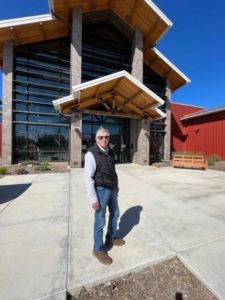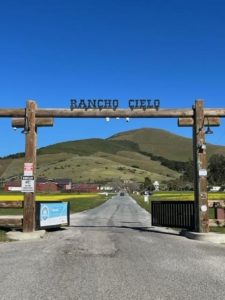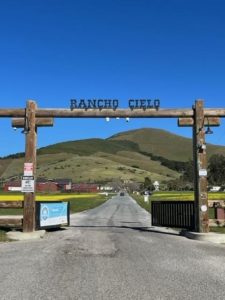In 1775-1776 the de Anza Expedition traveled from Sinaloa to San Francisco establishing the inland route from Mission San Gabriel to San Francisco. On their way north they camped in Natividad – now Salinas – along what is today Old Stage Road on their way to the site of Mission San Juan Bautista in San Benito County.
It was near there, on the eve of Memorial Day Weekend 2009, that I became involved in my first and thankfully only gun battle as a Deputy Sheriff. The suspect had just committed an armed home invasion robbery of an elderly couple and after trying to kill me and my fellow deputies fled on foot into the San Benito River. He was apprehended the next morning by Hollister PD Officer Bo Leland.
Today the suspect, Robert Giddings Jr, is serving a 23-year sentence for his part in that robbery. Californians will pay close to 2 million dollars to keep him there before he is released. It wasn’t his first serious crime and for the victim’s sake and the community’s protection, he’s where he belongs.
Unknown to me at the time, and along the same route traveled by de Anza, Judge John Phillips was trying to prevent what had happened on that night.
The Judge
When you meet Judge Phillips there are few trappings of officialdom. He wears the plaid shirts, jeans, and boots of a Salinas Valley farmer, yet has a UC Berkeley Law degree. When we met, he had just left the memorial service for Salinas Police Officer Jorge David Alvarado who had been gunned down on February 25th. His mood was somber – but determined and proud as he walked me around Rancho Cielo.
 The Judge, as he is known, is no stranger to crime and its consequences. For 13 years he served as a prosecutor in the Monterey County District Attorney’s before being appointed to the Superior Court where he served another 21 years tackling some of society’s seemingly intractable issues. Domestic violence, mental health, and gang violence. Enforcing California’s tough on crime sentences Judge Phillips thought we’re spending a lot on young offenders – but only once they commit a crime.
The Judge, as he is known, is no stranger to crime and its consequences. For 13 years he served as a prosecutor in the Monterey County District Attorney’s before being appointed to the Superior Court where he served another 21 years tackling some of society’s seemingly intractable issues. Domestic violence, mental health, and gang violence. Enforcing California’s tough on crime sentences Judge Phillips thought we’re spending a lot on young offenders – but only once they commit a crime.
The statistics are alarming. Youthful offenders stand a better than 60% likelihood of reoffending and the cost of incarceration has grown to nearly $90,000 per year. Put another way, a career criminal will cost California nearly 2 million dollars over the course of their criminal career, not including the profound impact both emotionally and economically on victims, their families, and the community.
In 2000 Judge Phillips and a group he calls “concerned citizens” cast their eye on the shuttered Natividad Boys Ranch, a mothballed juvenile detention facility on Old Stage Road with an idea to create a school for Salinas Valley’s most at-risk youth.
The obstacles seemed insurmountable. Since its closure the Natividad Ranch became the surplus depot and dump for Monterey County Public works, there was inadequate water supply, no sewer service, and dilapidated buildings. In short, not much at all but the closed dormitory and a lot of garbage. Furthering the challenge, The Packard Foundation funded a $26,000 study that concluded that the project was unfeasible and his team of mostly elected officials admittedly didn’t make much progress.
Too Many “Honorables”
That’s where his friend Ted Balestreri, the owner of Monterey’s famous Sardine Factory restaurant stepped in. He told the Judge, “You’ve got too many ‘honorables’ on your board, you need businesspeople, they know how to get things done.”
And so began the engagement of Monterey Counties business community. It took some convincing – and Judge Phillips leveraged every bit of his personal credibility selling the idea to sometimes skeptical community members who, once convinced, are now Rancho Cielo’s most generous partners and donors.
A walk around Rancho Cielo with the Judge is a story of synergy and resourcefulness. Plaques and buildings are adorned with the names of Monterey County’s businesses and individuals who in some cases have donated millions. But mostly it’s stories about the students that Judge Phillips is most proud.
Rancho Cielo
Today, Rancho Cielo sits on 100 acres and has an annual capacity of 120 students divided into a variety of programs. Its Silver Star Program is an alternative high school for non-violent probationers that includes academics, athletics, horsemanship (it’s a ranch after all), and cross-fit, to name a few. Across campus, the John Muir High School offers auto tech, building trades, and agriculture technology programs. Centered on campus is the Drummond Culinary School. Behavioral health programs are woven throughout the curriculum.
“Placement for culinary graduates is 100%,” according to the program director, Mark Bruszer whose graduates can be found in Monterey’s most exclusive restaurants as well as advanced Escoffier schools.
On my visit, the Building Trades Program students were building Cal Vets funded modular housing that upon completion would house homeless veterans in neighboring San Benito County. A  welding and metal fabrication program and workshop is under construction. A garden maintained by students provides seasonal produce for weekly dinners that are open to the public. In the Tech Lab, students are constructing soil moisture testing and irrigation equipment.
welding and metal fabrication program and workshop is under construction. A garden maintained by students provides seasonal produce for weekly dinners that are open to the public. In the Tech Lab, students are constructing soil moisture testing and irrigation equipment.
All of the programs, kitchens, classrooms, workshops, are filled with equipment donated by the community.
The numbers are amazing. Typically, only 40% of youthful offenders coming out of incarceration avoid rearrest in their first year out of incarceration, while 80% of court placed Rancho Cielo students do not reoffend. Muir graduates do even better. The annual budget of roughly 3.4 million dollars comes from a mix of grants, special events, contributions, and earned revenue. It holds the highest rating of “Platinum” by GuideStar. Tours and oversight by the community are welcomed.
3.4 million dollars might seem high for a 120 – student school, but when contrasted to the costs of homelessness and incarceration at $90,000 per year each excluding the millions in lost human potential – it’s a bargain.
Rancho Cielo is trying to become more self-sufficient. Campus housing, built by students, is being leased to Fresh Express for female farm labor housing providing a safe place for them to live. Plans to monetize its culinary program into product lines is under way. You might see Rancho Cielo Salsa on a shelf one day.
As we finished our walk the Judge told me that he and his wife Patti had recently attended a fundraiser for Natividad Medical Center where he ran into five Rancho Cielo alumni working at and attending the event. He told me that’s why he did it – for five like them.
He and Salinas have done it for thousands.
 www.ranchocieloyc.org
www.ranchocieloyc.org
